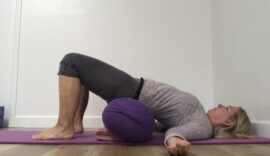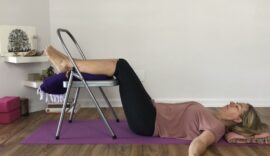Category: Uncategorized
Yoga for Prolapsed Pelvis: Gentle Solutions for Healing
Understanding the Causes and Symptoms of a Prolapsed Pelvis
A prolapsed pelvis, also known as pelvic organ prolapse, occurs when the muscles and tissues supporting the pelvic organs weaken, allowing these organs to drop or press into the vaginal or rectal area. While this condition is more commonly associated with women, men can also experience forms of pelvic prolapse, particularly involving the rectum. But how does this happen?
For women, the primary causes include childbirth, hormonal changes during menopause, chronic constipation, obesity, and heavy lifting. For men, factors like chronic straining, prostate surgery, or age-related weakening of the pelvic muscles can contribute. Both genders may also experience prolapse due to connective tissue disorders, repeated heavy lifting, or high-impact physical activities.
The symptoms of a prolapsed pelvis vary but often include a sensation of pressure or fullness in the pelvis, discomfort during physical activity, back pain, urinary or bowel dysfunction, and in some cases, a noticeable bulge in the vaginal or rectal area. These symptoms can significantly affect one’s quality of life, limiting daily activities and causing physical and emotional discomfort.
Are Strenuous and Intense Exercises Helpful for a Prolapsed Pelvis?
When dealing with a prolapsed pelvis, not all exercises are beneficial. Strenuous and high-impact activities, such as running, jumping, or heavy weightlifting, can exacerbate the condition by placing additional pressure on the pelvic floor muscles. This is particularly true for individuals with existing weakness or injury in the pelvic region.
Weightlifting, especially when done incorrectly or with excessive loads, is one of the most common culprits for worsening pelvic prolapse. The increased intra-abdominal pressure during such activities can strain the already compromised pelvic floor. Additionally, exercises that involve intense abdominal crunching or twisting movements can worsen symptoms.
Instead of strenuous exercises, it’s crucial to focus on low-impact and pelvic floor-safe activities. Gentle movement practices can help strengthen the supporting muscles without overloading them, paving the way for better recovery and symptom management.
How Yoga Can Help a Prolapsed Pelvis
Yoga offers a gentle and effective approach to managing a prolapsed pelvis. By focusing on mindfulness, controlled breathing, and pelvic floor-safe poses, yoga helps strengthen and stabilize the pelvic region while reducing strain. Here are some ways yoga supports this health issue:
- Improved Pelvic Floor Strength: Gentle poses such as Cat-Cow, Bridge Pose, and Child’s Pose encourage pelvic floor engagement without adding undue pressure. These postures activate the muscles needed for support and stability.
- Enhanced Body Awareness: Yoga emphasizes mindfulness and connection to the body. This awareness helps individuals identify poor movement patterns or habits that may worsen their condition.
- Stress Reduction: Chronic stress can increase muscle tension and exacerbate pelvic discomfort. Breathing exercises, meditation, and restorative yoga help calm the nervous system, promoting relaxation and healing.
- Postural Alignment: Poor posture can increase pressure on the pelvic floor. Yoga’s focus on alignment helps distribute weight evenly and alleviate stress on the pelvic muscles.
It is essential to practice under the guidance of a knowledgeable instructor who can tailor poses to your specific needs and avoid movements that could worsen the condition.
Tailored Yoga Practices for Prolapsed Pelvis Recovery
A customized yoga program can be highly beneficial for individuals suffering from a prolapsed pelvis. At Katrin Elia Yoga in Palm Harbor, FL, we specialize in creating personalized routines that address your unique challenges. With a focus on safe and effective methods, our programs aim to rebuild strength, enhance flexibility, and restore your confidence in movement.
If you’re ready to explore how yoga can support your recovery, contact us today.
Phone: 610.662.1130
Email: katrin@katrineliayoga.com
Let us guide you on the path to healing through the power of yoga.
Read MoreWhat is Restorative Yoga & Why Shall I Practice it?
Discover the Gentle Power of Restorative Yoga
In our fast-paced world, stress and anxiety often seem like constant companions. We rush through our days, rarely taking the time to truly relax and rejuvenate. This relentless pace can take a toll on our physical and mental health, leading to burnout, insomnia, and chronic pain. But what if there was a way to counteract these effects with a practice that emphasizes rest and renewal? Enter restorative yoga, a gentle and deeply relaxing style of yoga designed to soothe the nervous system and promote overall well-being.
The History of Restorative Yoga
Restorative yoga, as we know it today, owes much to the teachings of B.K.S. Iyengar, a pioneering yoga teacher from India. Iyengar's approach emphasized precise alignment and the use of props to support the body in various poses. This method evolved into what we now call restorative yoga, thanks to one of his prominent students, Judith Hanson Lasater. Lasater recognized the need for a practice that allowed individuals to deeply relax and heal, leading her to develop and popularize restorative yoga in the West.
The Benefits of Restorative Yoga
Restorative yoga offers a multitude of benefits for both the body and mind:
- Stress Reduction: By engaging the parasympathetic nervous system, restorative yoga helps lower cortisol levels, reducing stress and promoting a sense of calm.
- Improved Sleep: The deep relaxation techniques can improve sleep quality, making it easier to fall asleep and stay asleep.
- Enhanced Flexibility: Gentle stretching allows for greater flexibility and mobility without the risk of injury.
- Pain Relief: The use of props supports the body, alleviating tension and chronic pain, especially in the back, neck, and shoulders.
- Emotional Healing: By creating a space for introspection and mindfulness, restorative yoga helps release emotional blockages and fosters mental clarity.
Who Should Practice Restorative Yoga?
Restorative yoga is suitable for almost everyone, regardless of age or fitness level. It is especially beneficial for:
- Individuals with High Stress Levels: Those experiencing chronic stress or anxiety will find restorative yoga particularly calming.
- People with Chronic Pain or Injuries: The gentle nature of the practice makes it accessible to those with physical limitations or recovering from injuries.
- Beginners: Newcomers to yoga can start with restorative poses to build confidence and understanding of basic yoga principles.
- Seniors: The use of props and gentle movements make it an excellent choice for older adults seeking a low-impact form of exercise.
- Anyone Seeking Deep Relaxation: If you’re looking to unwind and recharge, restorative yoga provides the perfect environment to do so.
What Does a Restorative Yoga Practice Look Like?
A typical restorative yoga session involves the following elements:
- Use of Props: Bolsters, blankets, blocks, and straps are used to support the body in various poses, allowing for complete relaxation.
- Long Holds: Poses are held for an extended period, often 5-20 minutes, to facilitate deep release and relaxation.
- Few Poses: Unlike more dynamic styles of yoga, a restorative session may include only a few poses, each carefully chosen to promote rest and recovery.
- Focus on Breath: Breathing exercises are integrated to help calm the mind and enhance the relaxation response.
- Quiet Environment: Sessions are typically conducted in a serene, quiet setting to support the inward journey and mindfulness.
Call to Action: Experience the Tranquility of Restorative Yoga
If you are curious and would like to try a class, please contact Katrin Elia Yoga/Healing Center in Palm Harbor, FL and schedule your first session as a private (online or in-studio). The studio also offers a group class in a hybrid format (online & in-studio) every last week of the month (www.katrineliayoga.com). Phone: 610.662.1130 or email: katrin@katrineliayoga.com
Read More




